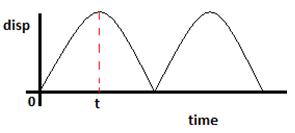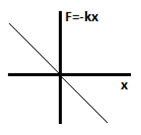This set of Class 11 Physics Chapter 14 Multiple Choice Questions & Answers (MCQs) focuses on “Oscillations”. These MCQs are created based on the latest CBSE syllabus and the NCERT curriculum, offering valuable assistance for exam preparation.
1. Every periodic motion is oscillatory, but not vice versa. True or False?
a) True
b) False
View Answer
Explanation: Periodic motion is motion that repeats itself at regular intervals of time. Oscillatory motion is periodic motion where there is an equilibrium point. When a body is given a small displacement from this equilibrium position, a force will act on it towards the equilibrium position. Thus, we can say that every oscillatory motion is periodic but not vice versa.
2. Which of the following describes circular motion?
a) Periodic
b) Oscillatory
c) Simple Harmonic
d) Rectilinear motion
View Answer
Explanation: The motion is periodic as it repeats its path at regular intervals. It is not oscillatory because there is no specific equilibrium position. Rectilinear motion means linear motion.
3. The graph given below represents motion of what? And what type of motion is it? Assume that the downward direction in the graph is negative. Also find the value of t. Assume no loss of energy anywhere. Assume disp =0 implies ground level.

a) Ball thrown up with velocity u, periodic motion, t = u/g
b) Ball left from a height h, periodic motion, t = √(2h/g)
c) Ball thrown up with velocity u, oscillatory motion, t=u/g
d) Ball thrown up with velocity u, periodic motion, t=2u/g
View Answer
Explanation: At t=0, displacement is zero. Thus, the ball starts from the ground. When the ball is thrown upward with velocity u, using equation v=u-at, we get:
v = 0 at t = u/g, which is the topmost point of the graph. The motion is periodic with a time period 2t=2u/g.
4. In SHM, force at extreme position is zero. True or False?
a) True
b) False
View Answer
Explanation: In SHM, the extreme position is where the particle is at instantaneous rest. Force on it is given by the relation F=-kx, where x is the distance from the equilibrium position. This shows that force is maximum at extreme positions since x is maximum. The graph of force vs position also shows the same.

5. A ball is thrown up with a velocity of 2.5m/s. It collides elastically with the ground. Find the frequency of this periodic motion.
a) 1Hz
b) 2Hz
c) 3Hz
d) 0.5Hz
View Answer
Explanation: The motion will repeat itself after the ball hits the ground every time. The time taken for the ball to reach the topmost position is t = u/g.
This will also be the time to reach the ground.
Thus, total time = 2u/g.
This will be the time period.
Frequency = 1/T = g/2u
= 10/5 =2Hz.
6. A function has the equation Acos3t + Bsin3t. Find the value of time period.
a) π/3
b) 2π/3
c) Aπ/3 + Bπ/3
d) π/3A + π/3B
View Answer
Explanation: Acos3t + Bsin3t = √(A2 + B2) [sin(3t+a)],
where sin(a) = (A/√(A2 + B2)).
Thus, the time period will be 2π/3.
Here, √(A2 + B2) will be the amplitude.
7. A force given by: F = -2(x – 1)2acts on a particle at rest. Select the correct option regarding the same.
a) Force acts on particle along the positive x direction
b) Force is never zero
c) Motion is periodic but not oscillatory
d) Motion is rectilinear
View Answer
Explanation: Force always acts in the negative direction, so motion is not periodic. Motion is rectilinear since the particle will always travel in a straight line. Force is zero at x=1.
8. What is the frequency of SHM?
a) Number of oscillations per unit time
b) Time for one oscillation
c) Time taken for motion to reverse direction
d) Same as angular frequency
View Answer
Explanation: Frequency is defined as the number of oscillations per unit time. Its unit is Hz. It is related to the angular frequency w by the relation: f = w/2π.
9. Force on a particle is given by: F = -kxn. For what values of n will the motion be oscillatory?
a) 3
b) 4
c) Any integer
d) It cannot be oscillatory for any value of n
View Answer
Explanation: For motion to be oscillatory there has to be an equilibrium position towards which the force is acting throughout the motion. In the expression, F = -kxn,
If n is even, force will always act in one direction.
If n is odd, force will change direction when x changes direction and will always act towards the origin.
Hence, motion will be oscillatory if n is odd.
Thus, from the given options 3 is correct.
10. A displacement function is given by: x = exp(sin2t). It is periodic. True or False?
a) True
b) False
View Answer
Explanation: exp(sin2t) is an exponential function.
But the value of exponent sin2t repeats after every interval of π,
so the given function is periodic with a time period π.
More MCQs on Class 11 Physics Chapter 14:
- Chapter 14 – Oscillations MCQ (Set 2)
- Chapter 14 – Oscillations MCQ (Set 3)
- Chapter 14 – Oscillations MCQ (Set 4)
- Chapter 14 – Oscillations MCQ (Set 5)
- Chapter 14 – Oscillations MCQ (Set 6)
- Chapter 14 – Oscillations MCQ (Set 7)
- Chapter 14 – Oscillations MCQ (Set 8)
- Chapter 14 – Oscillations MCQ (Set 9)
To practice all chapters and topics of class 11 Physics, here is complete set of 1000+ Multiple Choice Questions and Answers.
If you find a mistake in question / option / answer, kindly take a screenshot and email to [email protected]
- Practice Class 11 - Mathematics MCQs
- Practice Class 12 - Physics MCQs
- Practice Class 11 - Biology MCQs
- Check Class 11 - Physics Books
- Practice Class 11 - Chemistry MCQs
